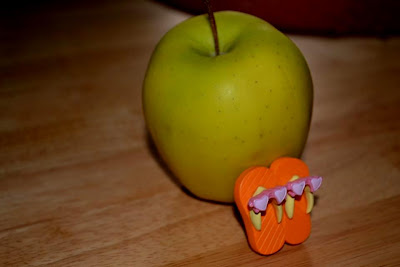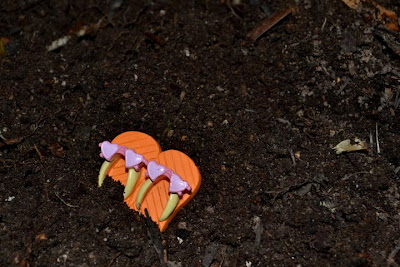A simple fruit is a type of fruit that is created from only one pistol thats from a simple or compound ovary in a flower. Some examples are bananas and apples.
Sources: Simple fruit. (May 11, 2008) biology-online.org. Retrieved on September 5, 2011, from
http://www.biology-online.org/dictionary/Simple_fruit
This blog will contain 20 biology vocabulary words. Each blog will contain the word, description, a photo showing an example of that word, and the source the information came from. Also, each picture will have a "widget" or "mascot" that provides proof that I took the picture. My mascot is a flip flop magnet. Hope you enjoy!
Tuesday, September 6, 2011
Aggregate fruit
An aggregate fruit is a type of fruit that is made from one single flower that has numerous pistols. Raspberries, blueberries, and strawberries are some prime examples. This is why I drew a strawberry.
Sources: Aggregate fruit. (June 5, 2009) biology-online.org. Retrieved on September 5, 2011, fromhttp://www.biology-online.org/dictionary/Aggregate _fruit
Base
In chemistry, the pH is the measure of basicality or acidity a substance has. Some people use the pH scale to determine how acidic or basic the substance is. It ranges from 0-14. A pH greater than 7 is considered a base. An example of a base is egg whites, which is why there is a picture of an egg white below. Some common qualities of a base would be that they sometimes will have a slippery feel to them, and they are bitter.
Source:
N/AOrganism
To be considered an organism it must apply to the following...it must
- React to change
- Be able to reproduce
- Maintain homeostasis
- Grow
Source: Organism. (June 17, 2008). biology-online.org. Retrieved on September 5, 2011, from
http://www.biology-online.org/dictionary/Organism
http://www.biology-online.org/dictionary/Organism
Herbivores
A herbivore is an animal that feeds off of mainly grasses and other plants. Many hooved animals are herbivores such as moose and deer. Some other herbivores are pandas, rabbits, and rhinos. Many dinosaurs are believed to also of been herbivores, such as the parasaurolophus. This specific dinosaur was drawn below as an example of a herbivore.
Source: Herbivore. (May 11, 2007). biology-online.org. Retrieved on September 5, 2011, from
http://www.biology-online.org/dictionary/Herbivore
http://www.biology-online.org/dictionary/Herbivore
Invertebrate
Invertebrates lack a vertebrae, so it does not have a back bone. An example of an invertebrate is a starfish which is why i took a picture of one to represent this specific vocabulary word.
Source: Invertebrate. (October 3, 2005). biology-online.org. Retrieved on September 5, 2011, from
http://www.biology-online.org/dictionary/Invertebrate
http://www.biology-online.org/dictionary/Invertebrate
Heterotroph
A heterotroph is an organism that is not self sufficient. In other words, it is not like a plant, where it can create its own food and survive on its own. They are unable to synthesize, therefore they depend on other organic matter created by other organisms. Examples of a heterotroph could be a dog, an elephant, humans, lions, and many others. The drawing below is another example of a heterotroph, which is a south african oryx. This animal is a herbivore, which means it needs organisms such as grass and other vegitation to survive.
Source: Heterotroph. (July 6, 2008). biology-online.org. Retrieved on September 5, 2011, from
http://www.biology-online.org/dictionary/Heterotroph
http://www.biology-online.org/dictionary/Heterotroph
Stamen
Stamen is the reproduction organ of a flower. It is the one of the male organs, and it usually has two parts; the stalk and the anther which has pollen on it. The pollen grains on the anther in angiosperm plants is the basic building block for reproduction. The picture shows the stamen of a flower and it is located at its' center and is sticking outwards.
Source: Stamen. (October 3, 2005). biology-online.org. Retrieved on September 5, 2011, from
http://www.biology-online.org/dictionary/Stamen
http://www.biology-online.org/dictionary/Stamen
Sepal
A sepal is a seperate part of the flower forming the calyx. It is usually green. This is used to protect the flower bud. There are usually the same number of sepals as their are petals. In the following picture, you can see some of the sepals on the upper stem and their also are some on the underside of the petals, but they aren't very visible.
Source: Sepal. (October 3, 2005). biology-online.org. Retrieved on September 5, 2011, from
http://www.biology-online.org/dictionary/Sepal
http://www.biology-online.org/dictionary/Sepal
Monday, September 5, 2011
Photosynthesis
Photosynthesis is the process in which a plant uses natural resources such as light, water, and carbon dioxide and then creates oxygen and glucose. The plant uses its chlorophyll to capture the light. An example of a plant that does photosynthesis is a flower.
Source: Photosynthesis. (February 2, 2009). biology-online.org. Retrieved on September 4, 2011, fromhttp://www.biology-online.org/dictionary/Photosynthesis
Fermentation
Fermentation is when organic foods are broken down into simpler compounds. This creates energy, aka ATP, in the process. This is known as an anerobic cellular process. An example of fermentation is alcohol.
Source: Fermentation. (September 30, 2008). biology-online.org. Retrieved on September 4, 2011, fromhttp://www.biology-online.org/dictionary/Fermentation
Bryophyte
A bryophyte lacks vascular tissue, and is mainly only capable of growing/living in moist environments. The majority of bryophytes are mosses, which is why there is a photo of moss in the following picture. This moss was found at the bottom of a tree near a pond, which is why it can survive (because the evironment is usually moist).
Source: Bryophyte. (April 15, 2007). biology-online.org. Retrieved on September 5, 2011, fromhttp://www.biology-online.org/dictionary/Bryophyte
Source: Bryophyte. (April 15, 2007). biology-online.org. Retrieved on September 5, 2011, fromhttp://www.biology-online.org/dictionary/Bryophyte
Topsoil
Topsoil is pretty much self- explanatory. It is the upper layer of soil. Its technical name would be the A-Horizon part of soil. It is usually rich in humus. This picture is a photo of topsoil.
Source: Topsoil. (October 3, 2005). biology-online.org. Retrieved on September 3, 2011, from
http://www.biology-online.org/dictionary/Topsoil
Source: Topsoil. (October 3, 2005). biology-online.org. Retrieved on September 3, 2011, from
http://www.biology-online.org/dictionary/Topsoil
Sunday, September 4, 2011
Fungi
Fungi is the Kingdom of eukaryotic organisms that lack chlorophyll and vascular tissue. Fungi have spores, and the reproduction occurs through them. They also have chitinous cell walls. The picture below is a type of mushroom.
Source: Fungi. (June 15, 2008). biology-online.org. Retrieved on September 4, 2011, from
http://www.biology-online.org/dictionary/Fungi
Source: Fungi. (June 15, 2008). biology-online.org. Retrieved on September 4, 2011, from
http://www.biology-online.org/dictionary/Fungi
Multiple Fruit
Multiple fruits are develped from the ovaries of many flowers. This grows into a cluster which creates a larger fruit. An example of a multiple fruit is a pinecone.
Source:
Multiple fruit. (June 5, 2009). biology-online.org. Retrieved on September 4, 2011, from http://www.biology-online.org/dictionary/Multiple_fruit
Angiosperm
An angiosperm is a flowering plant. Angiosperm produce seeds that are enclosed in an ovary. They are split between two groups which are dicots and monocots. The example of an angiosperm that is below shows how there are many seeds in/on it.
Sources: Angiosperm. (October 3, 2005) biology-online.org. Retrieved on September 4, 2011, from
http://www.biology-online.org/dictionary/Angiosperm
http://www.biology-online.org/dictionary/Angiosperm
Acid
In chemistry, the pH is the measure of basicality or acidity a substance has. Some people use the pH scale to determine how acidic or basic the substance is. It ranges from 0-14. A pH less than 7 is considered an acid. An example of an acid is soda or lemon juice, which is why there is a picture of soda below. Gases can be considered an acid as well, such as hydrogen chloride. Some common qualities of an acid would be that they can be corrosive and tasting sour.
Source:
N/A
Subscribe to:
Comments (Atom)

















